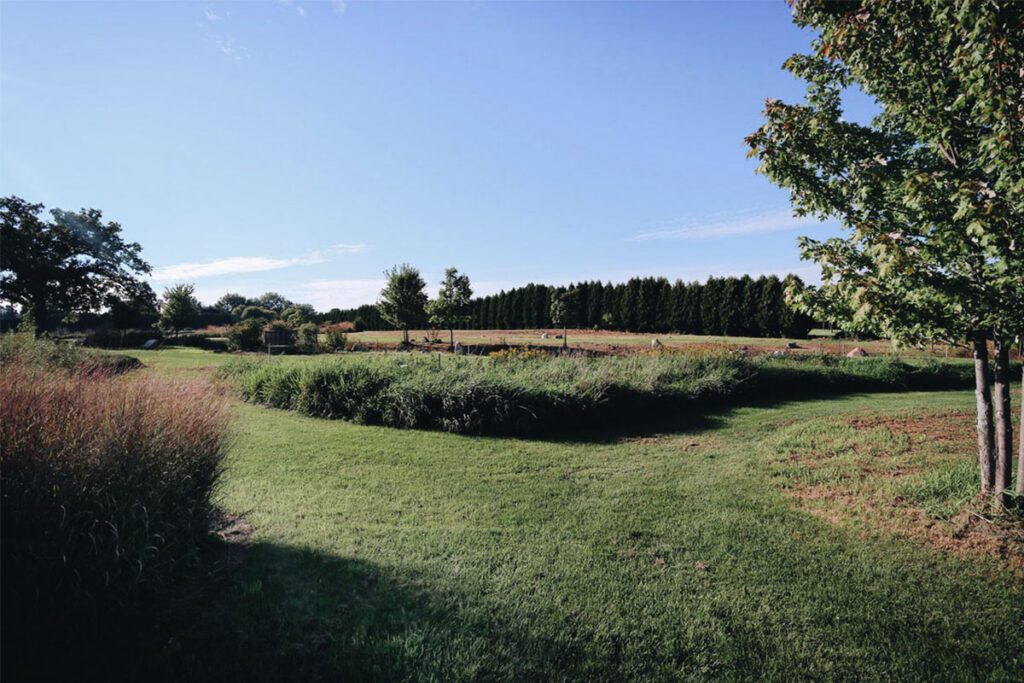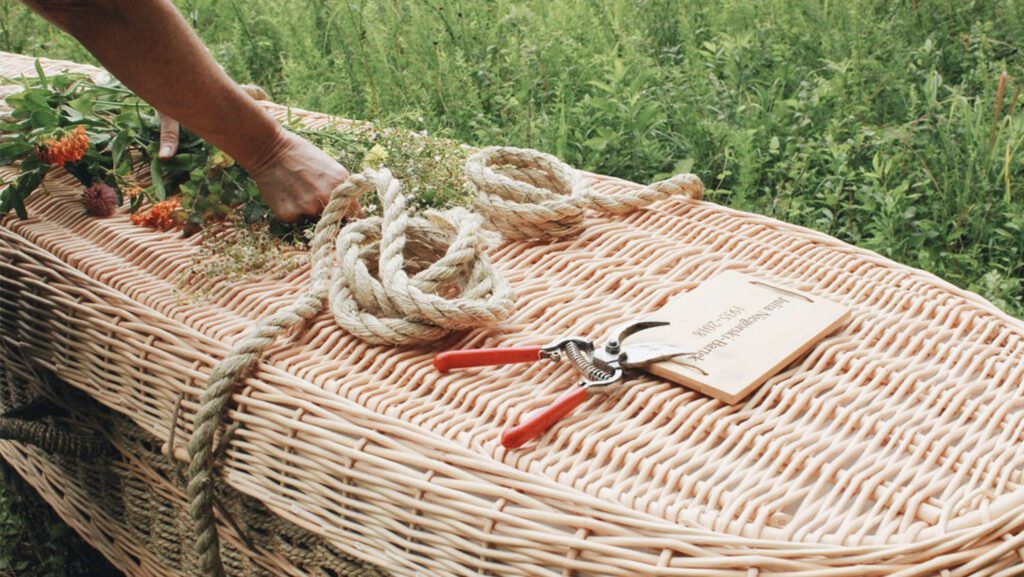My introduction to green burials came from a very personal place. My dad died unexpectedly when I was 19. During his funeral, he lay in his powder blue casket, looking very doll-like in his embalmed and makeup-adorned state. In my warped, grief-stricken brain, the makeup and casket all seemed a bit comical, and unsettlingly wrong.
Over a decade later, in my process of grieving and healing from the loss of my beloved dad, I’ve learned that his funeral felt wrong because, for me, it was. Years after his death, I read mortician, advocate, and author Caitlin Doughty’s memoir, Smoke Gets in Your Eyes. Her depictions of the autopsy process, body preparation, and cremation (what my father ultimately had) horrified me.
At the time, I wasn’t aware of an alternative like green burial, which is simply defined as the burial of a body without embalming, in a biodegradable container, shroud, or no container at all, directly into the ground without the use of a concrete vault or liner. The emphasis of a green burial is to care for the dead with minimal impact to the environment, via conservation of natural resources, reduction of carbon emissions, protection of worker health, and restoration and/or preservation of habitat. Green burial cemeteries, which may be standalone operations, or incorporated into a conventional cemetery, typically discontinue the use of herbicides, pesticides, and fertilizers, and encourage sustainable land management practices. Some green burial cemeteries even operate as conservation cemeteries, establishing a partnership with a conservation organization and using a conservation management plan that upholds best practices and provides perpetual protection of the land according to a conservation easement or deed restriction.
Choosing to have a green burial is one of the last important environmentally conscious choices you can make. According to the Green Burial Council, while traditional burial produces 250 lbs. of carbon, green burial sequesters 25 lbs. of carbon. This is equivalent to the carbon produced by the driving of an average American over a three-month period. With climate change full speed ahead, any decision we can make, big or small, including opting for a green burial, is worth considering.
On the other hand, traditional funerals and cremations seemed prescriptive, wasteful, and energy consumptive. In fact, they are all those things. Conventional burials in the United States use approximately 4.3 million gallons of embalming fluid (827,060 gallons of which is formaldehyde, methanol, and benzene), 20 million board feet of hardwoods (including rainforest woods), 1.6 million tons of concrete, 17,000 tons of copper and bronze, and 64,500 tons of steel, annually. Many of those materials leech into the surrounding soil over time. Not to mention the sourcing, processing, manufacturing, and transport of those materials uses a lot of energy as well.
Contrary to some belief, cremation isn’t a much better alternative, using fossil fuels to maintain high temperatures for multiple hours and producing 1.74 billion pounds of CO2 emissions annually in the United States. Cremation is the most popular disposition option in the United States (56.1 percent) and Canada (73.1 percent), with over 1.8 million and 224,000 cremations in 2020, respectively, according to the Cremation Association of North America. Cremation also releases mercury into the air and water, and creates byproducts of nitrogen oxide, dioxins, and particulates.
Crematory workers have a front row seat to these emissions too, which, along with exposure to embalming fluid, raises occupational concerns. Workers have a higher than average incidence of COPD, respiratory diseases, and neurological disorders. Embalmers in particular have a 13 percent higher death rate (Centers for Disease Control, Final Rights by Lisa Carlson and Joshua Slocum), are at 8 times higher risk for leukemia, and 3 times higher risk for ALS compared to the general population..
After learning all this, I thought to myself, “There has to be a better way.”

A green burial offers a more sustainable future
Once I had begun educating myself on green burials, I realized my own city of residence didn’t even allow them to occur. Although green burials are perfectly legal in the US and Canada, and elsewhere, many state and local laws make it difficult to have one. So I joined my city’s Municipal Board of Cemetery Trustees to attempt to change the ordinance that required all burials to include the use of a concrete vault. (The city just passed the change and will now allow burials beginning in June of this year).
My interest turned into a new passion and soon I found myself working with the Green Burial Council International, a nonprofit whose mission is to inspire and advocate for environmentally sustainable, natural deathcare through education and certification. Two years into my membership, I am the President of the Board of Trustees. Through my dive into the deathcare field, I’ve come to learn that that “better way” of deathcare lies in the process of providing our loved ones with a natural, or greener, burial when they die.
The emphasis of a green burial is to care for the dead via conservation, reduction of CO2, protection of worker health, and preservation of habitat.
The green burial process tends to fall on a spectrum when it comes to specific logistics. Some green burials use equipment to dig graves, while some don’t. Some cemeteries maintain green lawns, while others opt for a more natural appearance. The “ultimate” green burial, to me, would be a hand-dug grave, transportation of the body via horse drawn carriage (this is really a thing, by the way), and burial with no shroud or outer container. Fewer materials and energy-consuming practices lean towards the greenest of green burials. Historically, this is how burials were performed prior to the 1800s, when the advent of embalming fluid came into play to “preserve” Civil War soldiers killed on the battlefield so they could be shipped home to their families. The grave liner, or vault, was invented soon after, and that, combined with the modern casket, were meant to “protect” the body from animals and insects, grave robbers, and the elements. Prior to the modern funeral industry, green burials would have simply just been called “burials.”
Sure, the ultimate green burial may not be realistic for everyone. It may not feel right to a society that for the last two hundred or so years has adopted the conventional burial as the status quo. But with climate change a reality, thinking about even the smallest of changes to how we handle the dead is an important choice.
A traditional funeral typically necessitates a funeral home, a menu of casket options, pre-selected flower arrangements, funerary songs, and other stilted customs. Sure, there’s some customization involved, but traditional funeral customs are designed for the masses—which is probably part of why my dad’s funeral felt so awkward and impersonal. My dad’s funeral just wasn’t reflective of the funny, wonderful man he was. By bucking tradition, green funerals provide an atmosphere of healing, celebration and commemoration, and ritual in a league of its own. While the traditional funeral may be important to some, a green burial could provide a meaningful alternative, while avoiding a destructive carbon footprint.
How to plan for a green burial
Green burial is becoming a more readily available possibility across the United States, with nearly 350 cemeteries offering the option and counting. I encourage anyone interested in having a green burial to do some research and learn more in advance. Most importantly, if a green burial feels like the right choice for you, communicate that to your loved ones early and often, be it verbally or in a will. If you wish to have your last environmentally courteous action be to return to the earth via natural burial, let it be known. Here’s how to get started:
- Write down your wishes for a green funeral including where you want to be buried, that you do not want to be embalmed, and what, if anything, you would like to be buried in.
- Make arrangements with a funeral home in advance. This will help ensure you have secured a funeral home that will facilitate your wishes for a green burial.
- Choose a cemetery that offers natural burials and whose practices align with your level of sustainability.
- Share your plans with your loved ones, executor, and/or attorney.
- For additional resources, read Going Out Green: Four Ways to Ensure an Eco-Friendly Burial and Your Green Burial Planning Guide.
The views expressed in opinion pieces are those of the author(s) and do not represent the policy or position of LIVEKINDLY.


